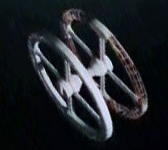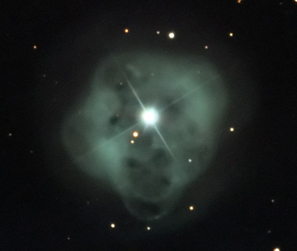So I’m sitting at home catching up on email, and I get a note from my friend Whitney who does press and outreach for the NASA infrared observatories Spitzer and WISE. There’s a new image from WISE that might be of interest, she claims. OK, I think, clicking the link; WISE images are usually a bit odd – astronomical objects tend to look very different in the far infrared than what I’m used to –but even then, when the image came up on my browser, I was struck by a major dose of holy frakitis:
Wow. And holy frak!* What the heck is that thing?
 You might be forgiven if your first thought is that it’s the space station from “2001: A Space Odyssey”. But in fact it’s something a bit more distant: it’s NGC 1514, the gas and dust surrounding a dying star system about 700 light years away.
You might be forgiven if your first thought is that it’s the space station from “2001: A Space Odyssey”. But in fact it’s something a bit more distant: it’s NGC 1514, the gas and dust surrounding a dying star system about 700 light years away.
I am somewhat familiar with these objects, having studied one for my Master’s degree, and a similar object for my PhD. But planetary nebulae, as they’re called, are so diverse and weird that understanding one, or even several, doesn’t always help in understanding all of them. And this one is seriously freaky. Those rings, lovely as they are, turn out to be quite difficult to explain.
OK, here’s the very brief skinny: when a star like the Sun ages and starts to die, it expands and cools off, becoming a red giant. It blows off a dense, slow wind, like the solar wind it emits now, but much thicker. Over the course of a few hundred thousand years, it can actually shed a lot of its mass. When it does that, it exposes its hot core. The wind speeds up and becomes thinner. This faster wind slams into the older, slower wind, and the collision can sculpt all kinds of weird and wonderful shapes. The hot core of the old star lights up this gas like a neon sign, and you get a planetary nebula (or PN; the plural is planetary nebulae, or PNe).
 I’m fond of PNe because they’re really quite lovely. Shown here on the left (click to embiggen; you should, it’s a beautiful picture, and note I flipped this and rotated it to match the WISE image) is what NGC 1514 looks like in visible light; note how different it looks than in the WISE far infrared view. In visible light, PNe glow a ghostly green due to oxygen atoms fluorescing. What you see here is the inner shell of material, the hot fast wind from the dying star. The overall shape is roughly round, but there are some features in it like the little loops at the bottom, and apparent cavities in the material or places where dust is blocking our view as well.
I’m fond of PNe because they’re really quite lovely. Shown here on the left (click to embiggen; you should, it’s a beautiful picture, and note I flipped this and rotated it to match the WISE image) is what NGC 1514 looks like in visible light; note how different it looks than in the WISE far infrared view. In visible light, PNe glow a ghostly green due to oxygen atoms fluorescing. What you see here is the inner shell of material, the hot fast wind from the dying star. The overall shape is roughly round, but there are some features in it like the little loops at the bottom, and apparent cavities in the material or places where dust is blocking our view as well.
But that view changes mightily – though not completely – in the IR. Mind you, WISE doesn’t have the resolution of the ground-based telescope that took the picture above, but even then you can still see some of the same features (I’ve put a close-up of the WISE picture below). The fuzzy green stuff in the WISE image is roughly comparable to what you see in the visible image (the green color is coincidence; the WISE image is false color, since it’s well outside what our eyes can detect).
 But those orange rings! What’s going on there?
But those orange rings! What’s going on there?
The quick answer is: no one knows. Rings like this are really hard to explain, mostly because the physics involved is fiercely complicated. Making things worse is that the star at the center of all this is actually a binary; two stars in orbit around each other. One is the hot, compact core of the dead star, while the other is a cooler giant star also nearing the end of its life. The orbital period of the two is just a few days, meaning they’re really zipping along. This adds angular momentum to the system, making a difficult situation even weirder. Gas is flowing around supersonically, slamming into already-existing walls of gas, and it’s a mess.
But there are a few things we can know. For one, those rings are roughly 0.6 light years in diameter – that’s 6 trillion kilometers (3.6 trillion miles). That number is not precise because the distance is not well known; the usual distance determination methods used by astronomers aren’t reliable for PNe, but 700 light years is a decent estimate.
The rings are very close together, separated by roughly 0.15 light years (1.5 trillion km, 900 billion miles). We see rings in quite a few PNe (NGC 3132 is another good example, as is the weird structure around Supernova 1987A), but they’re usually separated by about the same distance as their diameters. Obviously, something odd is going on here. If we assume the rings are actually circular loops seen at an angle (that’s a pretty solid assumption) then we can measure that the axis of the nebula is tilted to our line-of-sight by about 60° (in other words, were it tipped another 30° we’d see it exactly along its equator, and the rings would look like two parallel lines).
 In fact, weirdly, that space station picture above is a pretty close model of what this nebula looks like in the sky! See how, from our point of view, the loops overlap in the space station? The same thing is happening in NGC 1514. It’s tilted enough that the rings are superposed on one another. And the ring to the left is closer to us than the one on the right – I rotated the space station image to match the geometry. Another way to think of it is that the nebula is tipped so that we’re seeing the bottom of it on the left, like the tuna can in the picture. I know, I spare no expense in explaining the science here!
In fact, weirdly, that space station picture above is a pretty close model of what this nebula looks like in the sky! See how, from our point of view, the loops overlap in the space station? The same thing is happening in NGC 1514. It’s tilted enough that the rings are superposed on one another. And the ring to the left is closer to us than the one on the right – I rotated the space station image to match the geometry. Another way to think of it is that the nebula is tipped so that we’re seeing the bottom of it on the left, like the tuna can in the picture. I know, I spare no expense in explaining the science here!
The nebula rings aren’t really orange; again it’s a false color image. But what that color indicates is their temperature of about 160K, which is cold in human terms (about -110° C or -170° F) but astronomers would call that warm for a deep space object. What we’re seeing is almost certainly dust ejected by the star. But why rings?
The astronomer who found this object in the WISE data, Michael Ressler, has published a paper about it, but even after all the analysis done by him and his team, the reason the rings exist isn’t clear. Is it simply that the central star expelled a big cloud of dust, and we’re seeing it hit the gas from the old red giant? Or is the exposed core of the star sending out beams of material and energy that are hitting that gas, lighting them up? Certainly the fact that there are actually two stars in a tight orbit has something to do with this, but just what exactly?
No one knows. I chatted with Dr. Ressler about this last night, and we both expressed a need for high-resolution, deeper observations using Hubble (and maybe JWST, the infrared observatory that will succeed Hubble in a few years). And by “expressed a need”, I mean we both kinda sighed wistfully over having data like that. Planetary nebulae are totally cool, and amazingly beautiful, and wonderfully mysterious. A lot of the basic physics about them is well-understood, but when you dive into the details things get hard fast.
PNe are telling us that in many ways our understanding of the Universe is pretty good, but the closer you look, the more complicated things get. That’s not terribly surprising, but it once again affirms one of the most basic realities of science: the more you understand, the more there is to understand. In a long list of things I love about science, that one’s near the top.
Image credits: IR image: WISE ; Optical: Adam Block/NOAO/AURA/NSF
* Told ya.
Related posts:
- Night FLIERS
- The Helix’s dusty heart
- The first spectacular views of the sky from WISE
- 20 years ago today